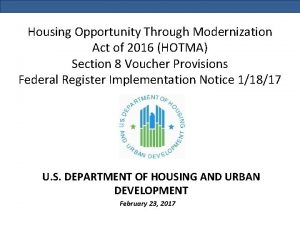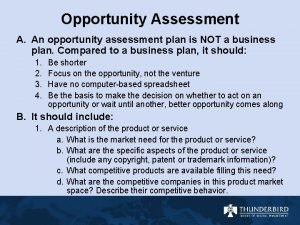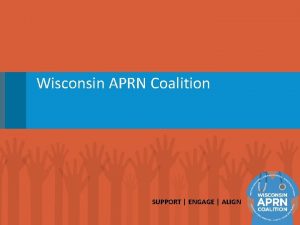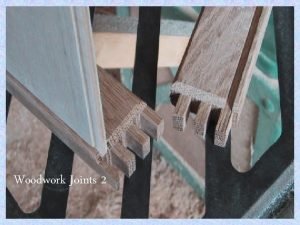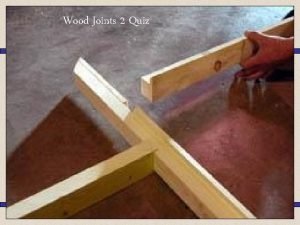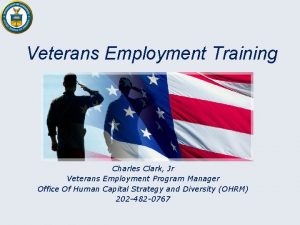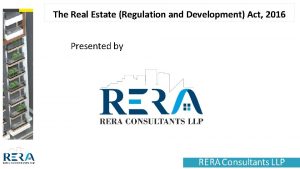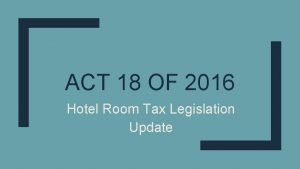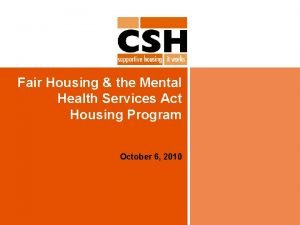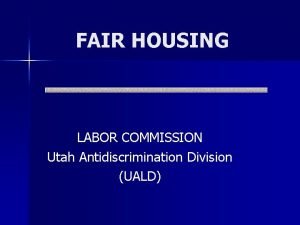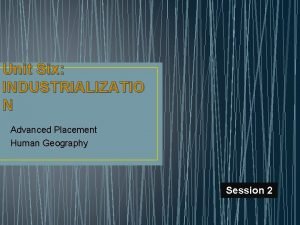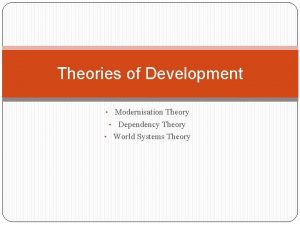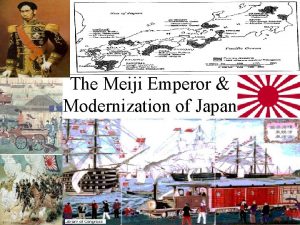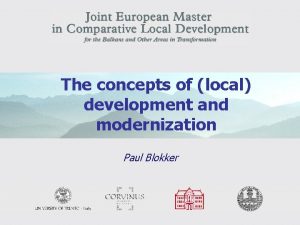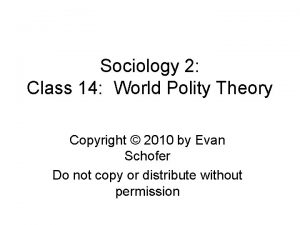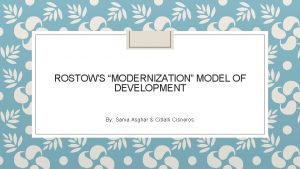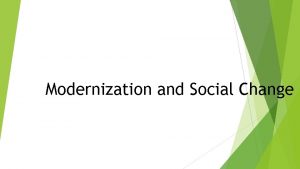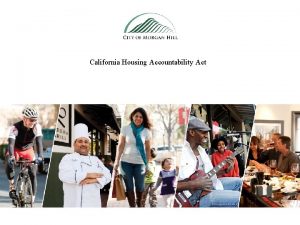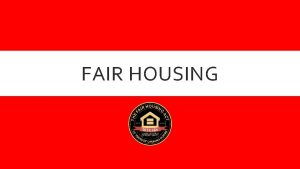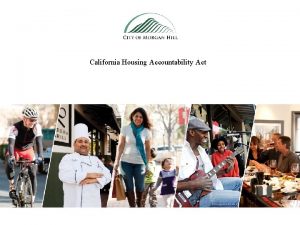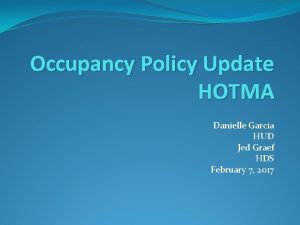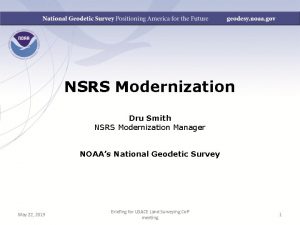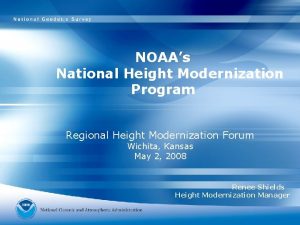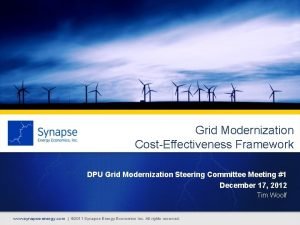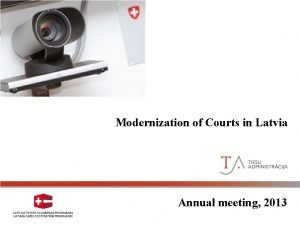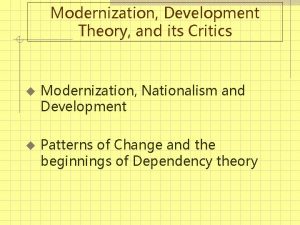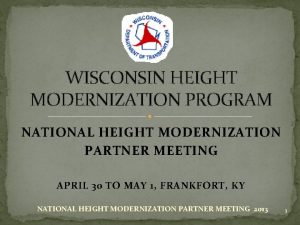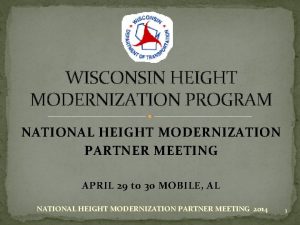Housing Opportunity Through Modernization Act of 2016 HOTMA























- Slides: 23

Housing Opportunity Through Modernization Act of 2016 (HOTMA) Section 8 Voucher Provisions Federal Register Implementation Notice 1/18/17 U. S. DEPARTMENT OF HOUSING AND URBAN DEVELOPMENT February 23, 2017

What is HOTMA? • The Housing Opportunity through Modernization Act of 2016 (HOTMA) – Passed House 427 -0 on 2/2/16 – Passed Senate by Unanimous Consent on 7/14/16 – Signed into law on 7/29/16 • HOTMA amends the U. S. Housing Act of 1937 and other housing laws to modify multiple HUD programs. – A majority of HOTMA provisions affect public housing and HCV • Some HOTMA provisions are effective immediately, some can be implemented by Notice, and others require rulemaking. 2

HOTMA Impact on PIH Programs • HOTMA makes numerous changes to the Housing Choice Voucher (HCV) and Public Housing Programs. • Main areas impacted by the HOTMA provisions: – Unit inspections in the HCV Program – Income and rent calculations for Public Housing, HCV, and Multifamily Housing – Project-based Voucher (PBV) assistance in HCV Program – Operating Fund/Capital Fund in Public Housing 3

What has HUD done to date? • HOTMA Notice 1: FR-5976 -N-01 (published 10/24/16) announced provisions impacting HUD programs that were effective immediately, three of which made modest changes to the Housing Choice Voucher (HCV program). • HOTMA Notice 2: FR-5976 -N-02 (published 11/29/16) seeks comment on proposed new income limit requirement to address issue of over-income families in public housing. – Comments were due 1/30/17. • HOTMA Notice 3: FR-5976 -N-03 (published 1/18/17) implements and seeks comment on provisions related to the HCV program. – Comments are due March 20, 2017. – Provisions take effect on April 18, 2017. 4

HOTMA Notice 3 • General Objectives of HOTMA Notice 3 Provisions: – Increase PHA administrative flexibility and reduce burden to better address local needs and priorities. – Support and expand the use of PBV for development and preservation of affordable housing. – Help improve voucher leasing rates in challenging rental markets. • HOTMA Notice 3 implements provisions covering four main areas: – – Inspection of dwelling units (Housing Quality Standards, HQS) Definition of PHA-owned units Project-based vouchers HCV assistance for families that own manufactured housing • Vast majority of these provisions are discretionary (i. e. , PHA may decide whether or not to implement). • Industry groups and stakeholders widely supportive of implementing HQS and PBV flexibilities as quickly as possible. 5

HCV Program Basics • HCV is HUD’s largest rental assistance program – $21. 4 billion annual budget (FY 2016 Appropriations Act) – Assists over 2 million families – Administered locally by 2, 200 public housing agencies (PHAs) • Provides monthly rental assistance to assist low-income families rent privately-owned housing • Primarily tenant-based assistance, meaning that the subsidy moves with the family – PHAs may project-based up to 20% of their HCV funding (effective April 18, 2017, changes to 20% of HCV units) 6

HCV Program Basics • PHAs created by State law to administer Federal housing programs within a specific area or jurisdiction • 2, 200 PHAs administer active HCV programs – The top 12 PHAs administer approximately 26 percent of the funding – The top 100 PHAs administer approximately 60% of the funding – Approximately 175 PHAs administer 50 or fewer units 7

How the Program Works • Admissions – A family applies to a PHA and is selected from waiting list • Generally must be very low-income family (at or below 50% of area median income) • 75% of PHA new admissions during PHA fiscal year must be extremely low-income families (at or below 30% of area median income) • Eligibility determination – PHA determines the family’s initial eligibility and issues family a voucher • Housing search – Family searches for eligible unit and owner willing to participate in the program. – Family may choose unit anywhere in the PHA’s jurisdiction or may “port” with their voucher to another jurisdiction 8

How the Program Works • PHA determines unit eligibility – Unit has reasonable rent (i. e. , does not exceed comparable unassisted units in the market area) – Unit meets the program’s Housing Quality Standards (PHA inspects the unit) – Unit is affordable (families may not pay more than 40% of adjusted monthly income when initially leasing any unit) • Family and owner execute a lease (including HUD Tenancy Addendum) • PHA and owner execute Housing Assistance Payments (HAP) contract • PHA makes monthly assistance payments directly to the owner • Family pays their share of the rent directly to owner 9

HCV Subsidy Calculation • Payment Standard caps the maximum subsidy that may be paid on behalf of a family – Established by PHA based on HUD published Fair Market Rent (FMR) for area based on bedroom size (basic range between 110 and 90% of FMR) – Exception Payment Standards • Housing assistance payment (HAP) is the lower of: – Payment standard minus family total tenant payment (TTP) – Gross rent of unit minus family (TTP) • Gross rent = rent to owner plus PHA utility allowance for tenant-paid utilities • Family TTP is highest of: – – • 30 percent of adjusted monthly income 10 percent of monthly income PHA minimum rent ($0 to $50) Welfare rent in “as-paid” states Family Share is gross rent minus TTP – If gross rent is above payment standard, family pays the difference in addition to TTP – Family may not pay more than 40% of ami when initially assisted in the unit if gross rent exceeds PS 10

HOTMA Provisions Related to Inspections • Occupancy prior to meeting HQS: Allows PHAs to authorize initial occupancy for units that fail HQS with non-lifethreatening conditions only. – PHAs must adopt HUD’s list of life-threatening conditions as provided in the Notice. • Alternative inspections: Allows PHAs to authorize occupancy prior to PHA’s initial HQS inspection for units on properties that have passed an alternative inspection in past 24 months. – Notice specifies what qualifies as an alternative inspection. – PHA still needs to conduct its own initial inspection within 15 days of the family’s submission of the Request for Tenancy Approval (RFTA). 11

HOTMA: PHA-Owned Units • New definition of what qualifies as a PHA-owned unit – Narrows the applicability of the definition to reduce the number of units that are considered PHA-owned. – Consequently reduces PHA cost and burden because if a unit is determined to be PHA-owned, the PHA is required to obtain services of an independent entity to perform certain PHA administrative functions (e. g. , unit inspections). • Noncompetitive selection of PHA projects for PBV assistance – Permitted if PHA has an ownership interest in the project and PHA is improving, developing, or replacing a public housing property or site. – Reduces PHA burden and streamlines PBV process for these projects. 12

Project-based Vouchers • HOTMA makes a number of significant changes to PBV, mostly designed to help facilitate and increase the use of PBVs • PHA is attaching HCV subsidy to a particular unit and project, subsidy will continue even if family leaves the unit – After initial year of assistance, family has right to move with tenant-based assistance (HCV or comparable tenantbased assistance) • PBV can be attached to existing housing or used for rehabilitation or new construction 13

Project-based Voucher Basics • Rehabilitation or New Construction – PHA and owner enter into an Agreement to Enter into a HAP Contract (AHAP) that covers rehab or construction phase • Description of the features of the housing – Site, location, number of contract units, size of contract units, accessibility requirements, estimated initial rents, description of the work, timing of completion of work, etc. • Applicable Federal Requirements – Section 3 training/employment opportunities, equal employment opportunity, Davis-Bacon requirements, health and safety, subsidy layering restrictions, uniform relocation, protection of inplace tenants, etc. 14

Project-based Voucher Basics • Rehabilitation, New Construction, and Existing Housing – PHA and owner execute HAP contract • HAP contract for the project, unlike tenant-based assistance, not one HAP contract for each unit – PHA refers eligible families from PHA waiting list to owner – Makes payments to owner for units under HAP • PHA may at its discretion make vacancy payments (may not exceed two full months following the move-out month 15

Project-Based Vouchers • PBV Rents – Rent to owner limited by the lowest of: • • 110 percent of FMR Exception Payment Standard if applicable Rent reasonableness determination Rent requested by owner – If all utilities are not included in rent, the maximum rent to owner is further reduced by the applicable tenant utility allowance – Family pays Total Tenant Payment (in most cases 30 percent of adjusted monthly income) 16

Project-Based Vouchers • Current Use of PBV by PHAs – Close to 600 PHAs administer PBV (out of approximately 2200 PHAs) – Approximately 160, 000 PBV units • About 7% of all vouchers under lease out of 2. 1 million non-MTW units – Program Cap Impact • About 70 PHAs have more than 18 percent of HCV units under PBV 17

Provisions Related to PBV Program Limits • PHA program limit on PBV: – Prior to HOTMA: PHA may project-base up to 20% of PHA’s Housing Assistance Payment (HAP) funding – HOTMA: PHA may project-base up to 20% of PHA’s authorized units – Additional 10% of units may be project-based if units are for: • • homeless families veterans supportive housing for elderly and disabled projects located in low-poverty areas – Low-poverty area is a census tract where with a poverty rate of 20 percent or less. 18

Provisions Related to PBV Project Limits • Income mixing requirement (number of units within a project that may be PBV): – Prior to HOTMA: No more than 25% of project units may receive PBV • Limit does not apply to single family housing or units made available for elderly, disabled, or families receiving supportive services – HOTMA: PHA may project-base greater of 25 units or 25% of units in project • Limit does not apply to units made available for the elderly or families eligible for supportive services at the project • If project in low-poverty area, PHA may PBV up to 40% of units (not 25%) 19

Formerly HUD assisted Projects Not Subject to Program Cap or Income Mixing Requirement • Neither the PBV PHA program limit or income mixing requirement apply to projects that were previously assisted under certain HUD programs – Previously assisted within last 5 years – HUD-assisted Housing • • Public housing MF Housing receiving project-based Section 8, Rent Supp or RAP Section 8 mod rehab (including SRO) Section 202 Section 811 Section 236 Section 221(d)(3) or (d)(4) BMIR 20

Other PBV Provisions Implemented in Notice 3 • Increasing the length of the term of the PBV HAP contract – The initial term and any extensions may now be up to 20 years, for a maximum contract term (initial plus extensions) of 40 years (vs. 30 years pre-HOTMA). • Facilitating the project-basing of vouchers targeted for homeless veterans and families/youth aging out of foster care – PHAs may project base HUD-VASH and Family Unification Program (FUP) vouchers without additional HUD approval. • Preference for families that qualify for specific services, including disability-specific services 21

Provisions Related to Manufactured Housing • HOTMA allows PHA to assist families that own manufactured homes with housing costs that include: – Monthly payments for the purchase of the manufactured home – Utilities – Rent for the space on which their home is located • Previously the HCV program could only subsidize the rent for the space and the utilities. • Change will increase viability of manufactured homes as a potential affordable housing resource for those PHAs that choose to use their vouchers for this purpose. 22

Next Steps • Develop guidance on HOTMA Notice #3 in anticipation of the Notice’s effective date • Evaluate comments received on Notice #3 to determine whether changes need to be made to the Notice, either via a technical correction or other Federal Register Notice • Determine implementation strategy for the remaining HOTMA provisions that impact PIH programs, including: – – Income and rent provisions Additional HQS and PBV provisions Operating/Capital Fund flexibility Capital Fund Reserves for Replacement Account 23
 Housing opportunity through modernization act
Housing opportunity through modernization act An opportunity assessment plan:
An opportunity assessment plan: Wisconsin aprn modernization act
Wisconsin aprn modernization act Financial modernization act of 1999
Financial modernization act of 1999 Housing joints
Housing joints Stopped housing joint
Stopped housing joint Macbeth act 3-5 summary
Macbeth act 3-5 summary Veterans employment opportunity act
Veterans employment opportunity act Section 3 of ra 10912
Section 3 of ra 10912 Rerd act 2016
Rerd act 2016 Act 18 of 2016
Act 18 of 2016 Fair housing act mental illness
Fair housing act mental illness Utah fair housing act
Utah fair housing act By one man sin
By one man sin Dome of furcation
Dome of furcation Tangential sawing disadvantages
Tangential sawing disadvantages Nissim ezekiel night of the scorpion
Nissim ezekiel night of the scorpion Modernization model ap human geography
Modernization model ap human geography Modernization theory vs dependency theory
Modernization theory vs dependency theory Modernization in japan
Modernization in japan Conclusion of modernization
Conclusion of modernization World polity theory example
World polity theory example What are the 5 stages of rostow's model
What are the 5 stages of rostow's model Role of rrrlf in modernisation of libraries
Role of rrrlf in modernisation of libraries
